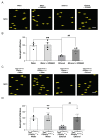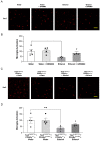Chronic Low-Dose Alcohol Consumption Attenuates Post-Ischemic Inflammation via PPARγ in Mice
- PMID: 34066125
- PMCID: PMC8150922
- DOI: 10.3390/ijms22105121
Chronic Low-Dose Alcohol Consumption Attenuates Post-Ischemic Inflammation via PPARγ in Mice
Abstract
Ischemic stroke is one of the leading causes of death and permanent disability in adults. Recently, we found that light alcohol consumption (LAC) suppresses post-ischemic inflammatory response, which plays an important role in ischemic brain damage. Our goal was to determine the role of peroxisome proliferator-activated receptor-gamma (PPARγ) in the anti-inflammatory effect of LAC against transient focal cerebral ischemia. In in vivo study, male C57BL/6J wild type (WT) and endothelial-specific conditional PPARγ knockout mice were gavage fed with 0.7 g/kg/day ethanol or volume-matched water daily for 8 weeks. From the 7th week, 3 mg/kg/day GW9662 (a selective PPARγ antagonist) was intraperitoneally given for two weeks. Cerebral ischemia/reperfusion (I/R) injury and expression of manganese superoxide dismutase (MnSOD) and adhesion molecules, neutrophil infiltration, and microglial activation in the cerebral cortex before and following a 90 min unilateral middle cerebral artery occlusion (MCAO)/24 h reperfusion were evaluated. In in vitro study, the impact of chronic alcohol exposure on expression of PPARγ and MnSOD in C57BL/6J mouse brain microvascular endothelial cells (MBMVECs) was measured. PPARγ and MnSOD were significantly upregulated in the cerebral cortex of ethanol-fed WT mice and low-concentration ethanol-exposed C57BL/6J MBMVECs. GW9662 significantly inhibited alcohol-induced upregulation of MnSOD. Eight-week ethanol feeding significantly reduced cerebral I/R injury and alleviated the post-ischemic inflammatory response (upregulation of intercellular adhesion molecule-1 (ICAM-1) and E-selectin, microglial activation, and neutrophil infiltration). Treatment with GW9662 and endothelial-specific conditional knockout of PPARγ did not alter cerebral I/R injury and the inflammatory response in the control mice but abolish the neuroprotective effect in ethanol-fed mice. In addition, GW9662 and endothelial-specific conditional knockout of PPARγ diminished the inhibitory effect of LAC on the post-ischemic expression of adhesion molecules and neutrophil infiltration. Our findings suggest that LAC may protect against cerebral I/R injury by suppressing the post-ischemic inflammation via activation of PPARγ.
Keywords: PPARγ; alcohol; inflammation; ischemic stroke.
Conflict of interest statement
We declare no conflict of interest.
Figures






References
-
- Benjamin E.J., Blaha M.J., Chiuve S.E., Cushman M., Das S.R., Deo R., de Ferranti S.D., Floyd J., Fornage M., Gillespie C., et al. Heart Disease and Stroke Statistics-2017 Update: A Report From the American Heart Association. Circulation. 2017;135:e146–e603. doi: 10.1161/CIR.0000000000000485. - DOI - PMC - PubMed
MeSH terms
Substances
Grants and funding
LinkOut - more resources
Full Text Sources
Miscellaneous

